|
|
|
Sort Order |
|
|
|
Items / Page
|
|
|
|
|
|
|
| Srl | Item |
| 1 |
ID:
099276
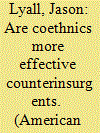

|
|
|
|
|
| Publication |
2010.
|
| Summary/Abstract |
Does ethnicity matter for explaining violence during civil wars? I exploit variation in the identity of soldiers who conducted so-called "sweep" operations (zachistki) in Chechnya (2000-5) as an empirical strategy for testing the link between ethnicity and violence. Evidence suggests that the intensity and timing of insurgent attacks are conditional on who "swept" a particular village. For example, attacks decreased by about 40% after pro-Russian Chechen sweeps relative to similar Russian-only operations. These changes are difficult to reconcile with notions of Chechen solidarity or different tactical choices. Instead, evidence, albeit tentative, points toward the existence of a wartime "coethnicity advantage." Chechen soldiers, enmeshed in dense intraethnic networks, are better positioned to identify insurgents within the population and to issue credible threats against civilians for noncooperation. A second mechanism-prior experience as an insurgent-may also be at work. These findings suggest new avenues of research investigating the conditional effects of violence in civil wars.
|
|
|
|
|
|
|
|
|
|
|
|
|
|
|
|
| 2 |
ID:
151115
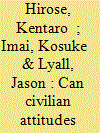

|
|
|
|
|
| Summary/Abstract |
Are civilian attitudes a useful predictor of patterns of violence in civil wars? A prominent debate has emerged among scholars and practitioners about the importance of winning civilian ‘hearts and minds’ for influencing their wartime behavior. We argue that such efforts may have a dark side: insurgents can use pro-counterinsurgent attitudes as cues to select their targets and tactics. We conduct an original survey experiment in 204 Afghan villages and establish a positive association between pro-International Security Assistance Force attitudes and future Taliban attacks. We extend our analysis to 14,606 non-surveyed villages and demonstrate that our measure of civilian attitudes improves out-of-sample predictive performance by 20–30% over a standard forecasting model. The results are especially strong for Taliban attacks with improvised explosive devices. These improvements in predictive power remain even after adjusting for possible confounders, including past violence, military bases, and development aid.
|
|
|
|
|
|
|
|
|
|
|
|
|
|
|
|
| 3 |
ID:
171339
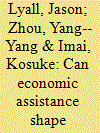

|
|
|
|
|
| Summary/Abstract |
Governments, militaries, and aid organizations all rely on economic interventions to shape civilian attitudes toward combatants during wartime. We have, however, little individual-level evidence that these “hearts and minds” programs actually influence combatant support. We address this problem by conducting a factorial randomized control trial of two common interventions—vocational training and cash transfers—on combatant support among 2,597 at-risk youth in Kandahar, Afghanistan. We find that training only improved economic livelihoods modestly and had little effect on combatant support. Cash failed to lift incomes, producing a boom-and-bust dynamic in which pro-government sentiment initially spiked and then quickly reversed itself, leaving a residue of increased Taliban support. Conditional on training, cash failed to improve beneficiaries’ livelihoods but did increase support for the Afghan government for at least eight months after the intervention. These findings suggest that aid affects attitudes by providing information about government resolve and competence rather than by improving economic livelihoods.
|
|
|
|
|
|
|
|
|
|
|
|
|
|
|
|
| 4 |
ID:
169324
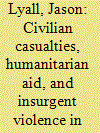

|
|
|
|
|
| Summary/Abstract |
Indiscriminate violence against civilians has long been viewed as a catalyst for new rounds of violence in civil wars. Can humanitarian assistance reduce violence after civilians have been harmed? Crossnational studies are pessimistic, drawing a connection between humanitarian aid and increased civil war violence, lethality, and duration. To date, however, we have few subnational studies of wartime aid and subsequent violence. To examine this relationship, I draw on the Afghan Civilian Assistance Program (ACAP II), a USAID-funded initiative that investigated 1,061 civilian casualty incidents (2011–13). Aid was assigned as if randomly to about half (55.8%) of these incidents, facilitating counterfactual estimation of how assistance affected Taliban attacks against the International Security Assistance Force, Afghan forces, and civilians. Challenging prior studies, I find that ACAP was associated with an average 23 percent reduction in attacks against ISAF, but not Afghan forces or civilians, at the village level for up to two years after the initial incident.
|
|
|
|
|
|
|
|
|
|
|
|
|
|
|
|
| 5 |
ID:
088414


|
|
|
|
|
| Publication |
2009.
|
| Summary/Abstract |
Does a state's use of indiscriminate violence incite insurgent attacks? To date, most existing theories and empirical studies have concluded that such violence is highly counterproductive because it creates new grievances while forcing victims to seek security, if not safety, in rebel arms. This proposition is tested using Russian artillery fire in Chechnya (2000 to 2005) to estimate indiscriminate violence's effect on subsequent patterns of insurgent attacks across matched pairs of similar shelled and nonshelled villages. The findings are counterintuitive. Shelled villages experience a 24 percent reduction in posttreatment mean insurgent attacks relative to control villages. In addition, commonly cited "triggers" for insurgent retaliation, including the lethality and destructiveness of indiscriminate violence, are either negatively correlated with insurgent attacks or statistically insignificant.
|
|
|
|
|
|
|
|
|
|
|
|
|
|
|
|
| 6 |
ID:
127829


|
|
|
|
|
| Publication |
2013.
|
| Summary/Abstract |
How are civilian attitudes toward combatants affected by wartime victimization? Are these effects conditional on which combatant inflicted the harm? We investigate the determinants of wartime civilian attitudes towards combatants using a survey experiment across 204 villages in five Pashtun-dominated provinces of Afghanistan-the heart of the Taliban insurgency. We use endorsement experiments to indirectly elicit truthful answers to sensitive questions about support for different combatants. We demonstrate that civilian attitudes are asymmetric in nature. Harm inflicted by the International Security Assistance Force (ISAF) is met with reduced support for ISAF and increased support for the Taliban, but Taliban-inflicted harm does not translate into greater ISAF support. We combine a multistage sampling design with hierarchical modeling to estimate ISAF and Taliban support at the individual, village, and district levels, permitting a more fine-grained analysis of wartime attitudes than previously possible.
|
|
|
|
|
|
|
|
|
|
|
|
|
|
|
|
| 7 |
ID:
090370
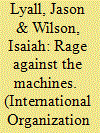

|
|
|
|
|
| Publication |
2009.
|
| Summary/Abstract |
During the nineteenth century, states routinely defeated insurgent foes. Over the twentieth century, however, this pattern reversed itself, with states increasingly less likely to defeat insurgents or avoid meeting at least some of their demands. What accounts for this pattern of outcomes in counterinsurgency (COIN) wars? We argue that increasing mechanization within state militaries after World War I is primarily responsible for this shift. Unlike their nineteenth-century predecessors, modern militaries possess force structures that inhibit information collection among local populations. This not only complicates the process of sifting insurgents from noncombatants but increases the difficulty of selectively applying rewards and punishment among the fence-sitting population. Modern militaries may therefore inadvertently fuel, rather than deter, insurgencies. We test this argument with a new data set of 286 insurgencies (1800-2005) and a paired comparison of two U.S. Army divisions in Iraq (2003-2004). We find that higher levels of mechanization, along with external support for insurgents and the counterinsurgent's status as an occupier, are associated with an increased probability of state defeat. By contrast, we find only partial support for conventional power- and regime-based explanations, and no support for the view that rough terrain favors insurgent success.
|
|
|
|
|
|
|
|
|
|
|
|
|
|
|
|
|
|
|
|
|